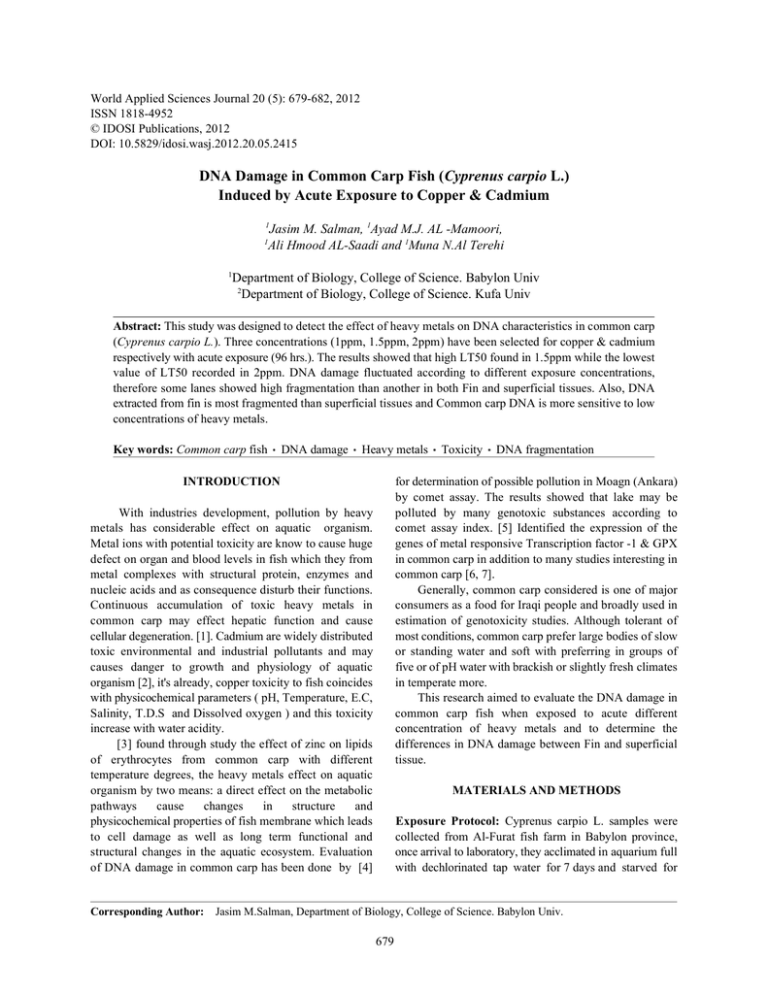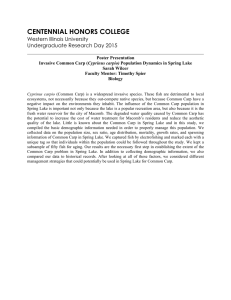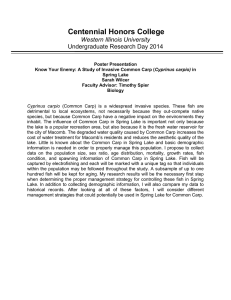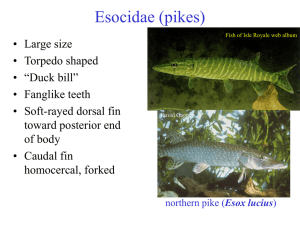World Applied Sciences Journal 20 (5): 679-682, 2012 ISSN 1818-4952 DOI: 10.5829/idosi.wasj.2012.20.05.2415
advertisement

World Applied Sciences Journal 20 (5): 679-682, 2012 ISSN 1818-4952 © IDOSI Publications, 2012 DOI: 10.5829/idosi.wasj.2012.20.05.2415 DNA Damage in Common Carp Fish (Cyprenus carpio L.) Induced by Acute Exposure to Copper & Cadmium Jasim M. Salman, 1Ayad M.J. AL -Mamoori, Ali Hmood AL-Saadi and 1Muna N.Al Terehi 1 1 1 Department of Biology, College of Science. Babylon Univ 2 Department of Biology, College of Science. Kufa Univ Abstract: This study was designed to detect the effect of heavy metals on DNA characteristics in common carp (Cyprenus carpio L.). Three concentrations (1ppm, 1.5ppm, 2ppm) have been selected for copper & cadmium respectively with acute exposure (96 hrs.). The results showed that high LT50 found in 1.5ppm while the lowest value of LT50 recorded in 2ppm. DNA damage fluctuated according to different exposure concentrations, therefore some lanes showed high fragmentation than another in both Fin and superficial tissues. Also, DNA extracted from fin is most fragmented than superficial tissues and Common carp DNA is more sensitive to low concentrations of heavy metals. Key words: Common carp fish DNA damage Heavy metals INTRODUCTION DNA fragmentation for determination of possible pollution in Moagn (Ankara) by comet assay. The results showed that lake may be polluted by many genotoxic substances according to comet assay index. [5] Identified the expression of the genes of metal responsive Transcription factor -1 & GPX in common carp in addition to many studies interesting in common carp [6, 7]. Generally, common carp considered is one of major consumers as a food for Iraqi people and broadly used in estimation of genotoxicity studies. Although tolerant of most conditions, common carp prefer large bodies of slow or standing water and soft with preferring in groups of five or of pH water with brackish or slightly fresh climates in temperate more. This research aimed to evaluate the DNA damage in common carp fish when exposed to acute different concentration of heavy metals and to determine the differences in DNA damage between Fin and superficial tissue. With industries development, pollution by heavy metals has considerable effect on aquatic organism. Metal ions with potential toxicity are know to cause huge defect on organ and blood levels in fish which they from metal complexes with structural protein, enzymes and nucleic acids and as consequence disturb their functions. Continuous accumulation of toxic heavy metals in common carp may effect hepatic function and cause cellular degeneration. [1]. Cadmium are widely distributed toxic environmental and industrial pollutants and may causes danger to growth and physiology of aquatic organism [2], it's already, copper toxicity to fish coincides with physicochemical parameters ( pH, Temperature, E.C, Salinity, T.D.S and Dissolved oxygen ) and this toxicity increase with water acidity. [3] found through study the effect of zinc on lipids of erythrocytes from common carp with different temperature degrees, the heavy metals effect on aquatic organism by two means: a direct effect on the metabolic pathways cause changes in structure and physicochemical properties of fish membrane which leads to cell damage as well as long term functional and structural changes in the aquatic ecosystem. Evaluation of DNA damage in common carp has been done by [4] Corresponding Author: Toxicity MATERIALS AND METHODS Exposure Protocol: Cyprenus carpio L. samples were collected from Al-Furat fish farm in Babylon province, once arrival to laboratory, they acclimated in aquarium full with dechlorinated tap water for 7 days and starved for Jasim M.Salman, Department of Biology, College of Science. Babylon Univ. 679 World Appl. Sci. J., 20 (5): 679-682, 2012 24 hrs. with photoperiod 12:12 light & dark cycle. The samples divided into different groups according to different concentration of copper & cadmium (1ppm, 1.5ppm, 2ppm) respectively and exposure extended to 96hrs, as acute exposure in aquarium under control conditions. Standard concentrations of copper & cadmium prepared from Cu2SO4.5H2O&CdNO3.4H2O respectively. [9]. DNA fragmentation recorded mostly in fin than superficial tissue due to fin regards as important parts in fish in movement and swimming and highly exposed to pollutants such as heavy metals and fluctuation between different concentration has been detected (Fig. 1) & (Table 1). These fluctuations returned to some factors effect on DNA damage positively or negatively, such as organic substances in water influences the availability of metal to fish and reduce metal toxicity and it's naturally that antioxidants enzymes reduce the heavy metals inhibitory effect such as GSH playing fundamental role as a first line defense against heavy metals toxicity. Due to Common carp have the high repair capacity to protect DNA integrity and according to previous reasons. The results showed less DNA fragmentation in high concentration. On the other hand, common carp has adaptive response in polluted aquatic environment and heavy metals cause a harmful effect by generating reactive oxygen species that leads to sever damage to cell by shifting the fluidity balance and make molecular complexes with cell protein and develop toxic effect on the cell towards dysfunction [10]. Heavy metals are vital inducers of oxidative stress in aquatic species which lead to formation of reactive oxygen species through two routes either by potential redox or without potential ability of redox [11] and as consequences, causes DNA damage. As we mentioned that High concentration of copper toxicity increase with low pH and going to be fatal to fish with increasing mobility and releasing into water column and the presence LT50 (Median Lethal Time): Median lethal time was determined using a log probable paper according to [8]. DNA Damage Evaluation: Immediately soft tissue& fin specimens were collected from common carp from fin and superficial tissue and processed according the protocol clarified by Promega Corporation, Madison, WI, U.S.A. After extraction, DNA samples were tested by UV Trans illuminator type (CS-Cleaver scientific Ltd., U.K). RESULTS AND DISCUSSION The risk of heavy metals pollution returned to their persistency in aquatic ecosystem. The results showed that (3548.1) is a highest value of LT50 for 1.5ppm and (0.161) is a lowest value of LT50 for 2ppmand this return to variation in fish response to different concentration and in some time, some species don't appear any response due to their acclimation to stress factors such as heavy metals. Common carp may be able to adjust themselves and adapted to low oxygen levels and poor food environment and has high ability to store heavy metals Table 1: Quantitative variations of DNA damage of common carp fish for different concentration of copper & cadmium. Lane number Treatment Lyses type DNA lyses level 1 DNA Ladder DNA MARKER 1250-100 bp 2 Fin 1ppm Cu Smear 600 3 Tissue 1ppm Cu No lyses - 4 Fin 1.5 ppm Cu 3 bands 200, 400, 500 Smear 700 5 Tissue 1.5ppm Cu smear 500 6 Fin 2ppm Cu 3 bands 200, 400, 500 Smear 800 7 Tissue 2ppm Cu smear 500 8 Fin 1.5 ppm Cd 4 bands 200, 400, 600, 800 Smear 800 200, 400, 600 9 Tissue 1.5 ppm Cd 3 bands Smear 600 10 Fin 1ppm Cd Smear 500 11 Tissue 1ppm Cd Smear 300 12 Fin 2ppmCd 3bands 200, 400, 500 Smear 500 13 Tissue 2ppm Cd Smear 400 680 World Appl. Sci. J., 20 (5): 679-682, 2012 Fig. 1: DNA profile from fin & superficial tissue of common carp fish (Cyprenus carpio L.) which induced by acute exposure (96 hrs.) by different concentration of Cu & Cd. Lane (1) DNA Marker, Lane (2) Fin 1ppm Cu, Lane (3) Tissue 1ppm Cu, Lane (4) Fin 1.5 ppm Cu, Lane (5) Tissue 1.5ppm Cu, Lane (6) Fin 2ppm Cu, Lane (7) Tissue 2ppm Cu, Lane (8) Fin 1.5 ppm Cd, Lane (9) Tissue 1.5 ppm Cd, (10) Fin 1ppm Cd, Lane (11) Tissue 1ppm Cd, Lane(12) Fin 2ppm Cd. Lane (13) Tissue 2ppm Cd. of toxic metal has strong influence on the hematological parameters in common carp. Cd can accumulate primarily in major organ tissues of fish such as liver, stomach & gill with low concentration of copper in muscles compared to those found in gill [12, 13]. In spite of common carp ability to accumulate heavy metals but high a mount induce biochemical metabolism and lead to regeneration of reactive oxygen species and as consequences cause Sever DNA damage [14, 15]. 4. 5. REFERENCES 1. 2. 3. 6. Rajamanickam V. and N. Muthuswamy, 2008. Effect of heavy metals induced toxicity on metabolic biomarkers in common carp (Cyprinus carpio L.). Mj. Int. J. Sci. Tech., 2(01): 192-200. Jia X., H. Zhang and X. Liu, 2011. Low levels of cadmium exposure induce DNA damage and oxidative stress in the liver of Oujiang colored common carp Cyprinus carpio var. Color. Fish Physiology Biochemistry, 37: 97-103. Gabryelak, T., A. Filipiak and G. Brichon, 2000. Effects of zinc on lipids of erythrocytes from carp (Cyprinus carpio L.) acclimated to different temperatures. Comparative Biochemistry and Physiology Part C 127: 335-343. 7. 8. 9. 681 Çok, I., O.K. Uluta , Ö. Oku luk, E. Durmaz and N. Demir, 2011. Evaluation of DNA Damage in common carp (Cyprinus carpio L.) by Comet assay for determination of possible pollution in Lake Mogan (Ankara). The Scientific World Journal: TSW Environment 11, 1455–1461. DOI 10.1100/tsw.2011.140. Ferencz, Á., 2010. Identification and expression of the genes of metal-Responsive transcription factor-1 and glutathione peroxidases of common carp. Ph. D thesis. University of Szeged, Hungary. Hermesz E. and Á. Ferencz, 2009. Identification of two phospholipid hydroperoxide gluthatione peroxidase (GPx4) genes in carp. Comp. Biochem. and Physiol. Part C, 150: 101-106. Said, A.K., A. Ferencz, J. Nemcsók and E. Hermesz, 2010. Expressions of heat shock and metallothionein genes in the heart of common carp (Cyprinus carpio): effects of temperature shock and heavy metal exposure. Acta Biol. Hung., 61(1): 10-23. Piegorsch, W.W. & A.J. Bailer, 2005. Analyzing environmental Data. John wiley & sons ltd. U.K. Sahan, A., E.B. Kurutas and T. Altun, 2010. The determination of biochemical indicators (biomarkers) in the common carp (Cyprinus carpio) to the physico-chemical parameters of the ceyhan river (Adana-Turkey). Ekoloji, 19(76): 8-14. World Appl. Sci. J., 20 (5): 679-682, 2012 10. Vinodhini, R. and M. Narayananr, 2009. Biochemical changes of antioxidant enzymes in common carp (Cyprinus carpio L.) after heavy metal exposure. Turk. J. Vet. Anim. Sci., 33(4): 273-278. 11. Sevcikova, M., H. Modra, Z. Slaninova and Z. Svobodova, 2011. Metals as a cause of oxidative stress in fish: a review. Veterinarni Medicina, 56: 537-546. 12. Yang, J., M. Arnush, O. Chen, X. Wu, B. Pange and X. ZhiJiang, 2004. Cadmium-induced damage to primary cultures of rat Leydig cells. Mutation Research/Genetic Toxicology and Environmental Mutagenesis, 559(1-2): 49-57. 13. Khayatzadeh, J. and E. Abbasi, 2010. The Effects of heavy Metals on aquatic animals. The 1st international applied geological congress, department of geology, Islamic azad University mashad branch, Iran, 26-28 April:688-694. 14. Aina, R., S. Sgorbati, A. Santagostino, M. Labra, A. Ghiani and S. Citterio, 2004. Specific hypomethylation of DNA is induced by heavy metals in white clover and industrial hemp. Physiologia Plantarum, 121(13): 472-480. 15. Vinodhini, R. and M. Narayanan, 2008. Bioaccumulation of heavy metals in organs of fresh water fish Cyprinus carpio (Common carp). Int. J. Environ. Sci. Tech., 5(2): 179-182. 682






